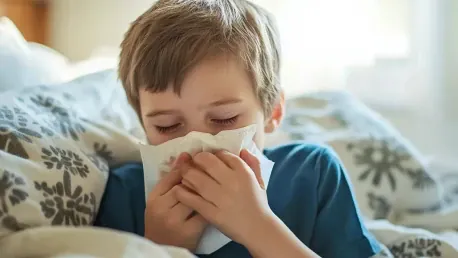Acute respiratory infections are a significant cause of both morbidity and mortality in young children globally, with an especially pronounced impact in low- and middle-income countries on children under five years old. Among the array of pathogens responsible for these illnesses, human metapneumovirus (hMPV) stands out as a major contributor, affecting both the upper and lower respiratory tracts. The role of hMPV in pediatric respiratory infections was the focus of a study recently published in the journal IJID Regions, which delved into the genetic diversity and prevalence of emerging hMPV lineages, particularly in children under five years old in India. The importance of this study is highlighted by the ongoing need to understand the public health implications and preparedness required for outbreaks of respiratory viruses.
The Significance of hMPV in Pediatric Respiratory Infections
Acute respiratory infections are a leading health threat to young children, particularly in less affluent settings. These infections often dictate the morbidity and mortality rates in this vulnerable population. hMPV is recognized as a principal pathogen driving respiratory illnesses by compromising both the upper and lower respiratory tracts. The study draws attention to the seasonal nature of hMPV infections, which tend to peak during the winter-spring seasons, specifically in December and January. This pattern mirrors the behavior of other respiratory viruses known to circulate during these months.
The genetic makeup of hMPV is categorized into two groups, A and B, with further subdivisions into lineages including A2.2.1 and A2.2.2. While global studies have provided insights into the evolving nature of these lineages, there is a paucity of data regarding their prevalence and genetic variability in specific regions of India. This is an important gap in the literature as the COVID-19 pandemic has shifted the dynamic spread of seasonal respiratory viruses, including hMPV. Understanding the genetic characteristics and clinical impact of hMPV in the Indian context is vital for devising effective prevention and control strategies.
Study Methodology and Data Collection
The comprehensive investigation spanned from January 2021 to June 2024, focusing on the prevalence and genetic diversity of hMPV in children under five in the Puducherry region of India. Inclusion criteria for this study required children presenting with influenza-like illness and acute respiratory infections, and those beyond five years of age were excluded from the sample. Nasopharyngeal specimens were collected, and RNA was extracted using standardized kits to ensure uniformity. Reverse transcription polymerase chain reaction (RT-PCR) was employed to screen the samples for hMPV, as well as for influenza and respiratory syncytial virus, to capture a broad scope of respiratory pathogens.
Between November 2022 and March 2023, during a notable outbreak, samples testing positive for hMPV with low cycle threshold values underwent further scrutiny. The focus of this detailed analysis was on the fusion protein gene, sequenced to identify the specific genetic lineages. Primers designed to target specific regions facilitated this process. Novel lineages such as A2.2.1 and A2.2.2 presented amino acid substitutions and unique glycosylation patterns. Of particular interest was O-linked glycosylation at position 191, which holds potential implications for immune evasion and stability of antigens.
Genetic Analysis and Findings
In the genetic analysis phase, cutting-edge bioinformatics tools were deployed to predict glycosylation sites and evaluate mutations in the fusion protein gene. These mutations had potential impacts on antigenicity and immune response effectiveness. Employing phylogenetic methods, researchers categorized the hMPV samples into recognized genotypes and subclusters. They mapped these mutations against global reference sequences, thus decoding their evolutionary importance. Site-specific selection analyses were executed to evaluate evolutionary pressures, and the potential interactions during co-circulation with other respiratory pathogens were closely examined.
Significant findings from the study showcased that hMPV played a crucial role in pediatric respiratory infections, with an overall positivity rate of 2.5% out of 4,519 samples studied. During the outbreak period, hMPV showed a substantial presence, accounting for 43.1% of respiratory infection cases, thus standing out as the leading pathogen. The infections predominantly affected children under one year of age, highlighting their specific vulnerability. Symptoms typically included flu-like manifestations, wheezing, and respiratory distress; severe cases progressed to pneumonia or bronchiolitis. Bilateral crepitations were a common finding, with a male-to-female ratio of 1.8:1 among the infected cohorts.
Implications of Novel Lineages
Phylogenetic scrutiny of 37 hMPV-positive samples revealed that a vast majority, 91.89%, belonged to genotype A, particularly sub-lineage A2.1, while 8.11% were from genotype B. The study identified novel lineages A2.2.1 and A2.2.2 within genotype A for the first time in India. These lineages exhibited distinctive mutations and glycosylation changes that could potentially impact immune evasion and pathogenicity. Notable substitutions such as G42V, E96K, and M250R in lineage A2.2.2 were significant, with glycosylation at position 191 possibly altering antigenic properties.
The study’s documentation of site-specific selection pressures and the ongoing genetic evolution in local strains were especially important. The infection rates’ peak during December and January aligned with established seasonal patterns for respiratory viruses. These discoveries underscored the diverse genetic nature of hMPV and its simultaneous circulation with other respiratory viruses, though co-infections were rare. The prevalence data corresponds with global findings but also points out regional nuances in seasonality and co-infection patterns. The emergent novel lineages highlighted their potential to impact disease severity and the critical necessity for ongoing surveillance to track genetic changes.
Public Health Implications and Future Directions
The thorough study extended from January 2021 to June 2024, concentrating on the prevalence and genetic diversity of hMPV in children under five in Puducherry, India. The study included children exhibiting influenza-like symptoms and acute respiratory infections, while excluding those older than five years. Nasopharyngeal samples were collected, and RNA was extracted using standardized kits, maintaining consistency. RT-PCR was utilized to screen for hMPV, influenza, and respiratory syncytial virus, covering a wide range of respiratory pathogens.
During a significant outbreak from November 2022 to March 2023, hMPV-positive samples with low cycle threshold values were examined further. The focus was on sequencing the fusion protein gene to identify specific genetic lineages. Primers were used to target certain regions, facilitating this detailed analysis. New lineages like A2.2.1 and A2.2.2 displayed amino acid substitutions and unique glycosylation patterns. Notably, the O-linked glycosylation at position 191 could impact immune evasion and antigen stability.









